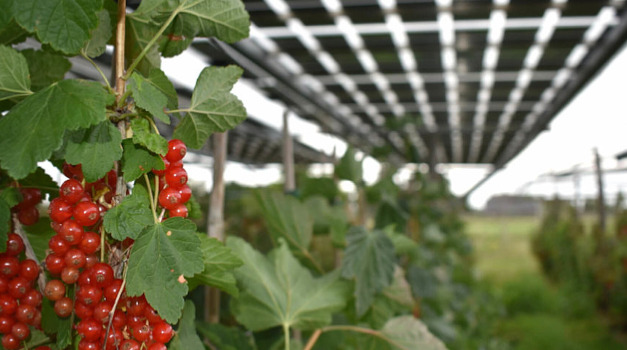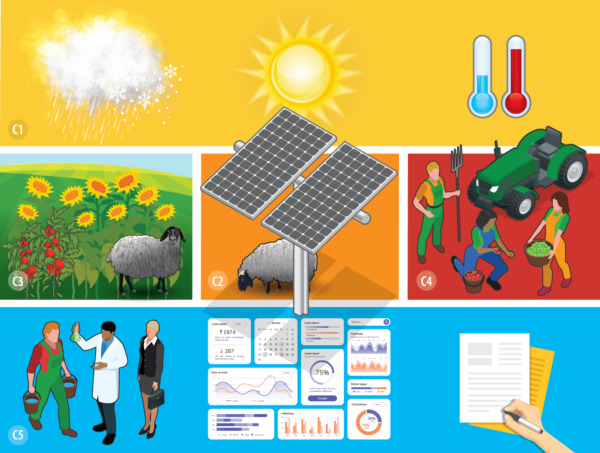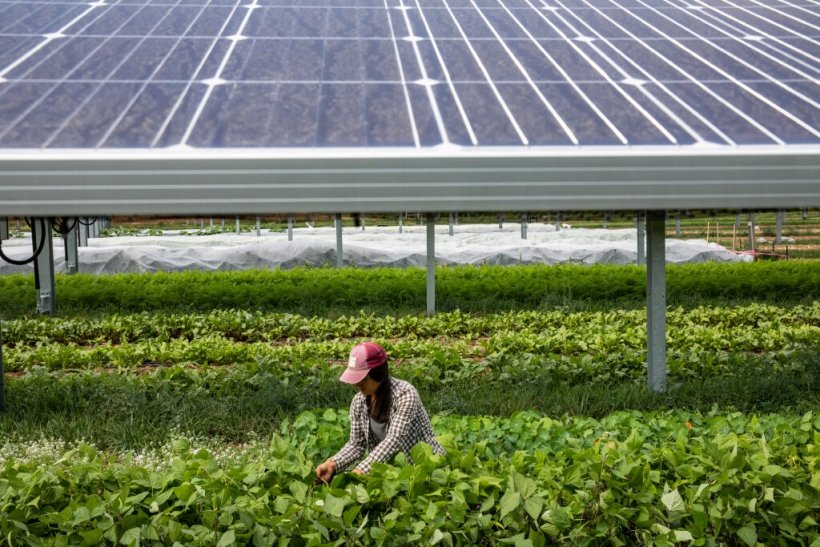How combining solar panels and crops can boost renewable energy production and food security in hot and drought-stricken regions
Prof. Aécio D’Silva, Ph.D
AquaUniversity
Agrivoltaics is co-locating solar panels and crops on the same land, creating a synergy that benefits both. This system can improve the performance of solar panels, increase the yield and quality of crops, reduce water consumption and evaporation, and provide income and employment opportunities for rural communities.
Solar energy is one of the most promising sources of renewable energy, as it is abundant, clean, and cost-effective. However, solar energy also faces some challenges, such as land use conflicts, environmental impacts, and variability of output. One way to address these challenges is to integrate solar energy with agriculture, creating a system known as agrivoltaics or AGPV. [1, 1a]
The term was coined by Adolf Goetzberger and Armin Zastrow in 1981 to describe the combination of photovoltaics (PV) and agriculture. Agrivoltaics involves installing solar panels above or between crops, creating a mutually beneficial relationship. The solar panels provide shade and protection for the crops, while the crops cool and humidify the air for the solar panels. The result is a higher efficiency and output of solar energy and a higher yield and quality of crops. [1b]
Agriculture Voltaics can also provide other benefits, such as reducing water consumption and evaporation, enhancing biodiversity and soil health, diversifying income and employment opportunities, and increasing food and energy security. Agrivoltaics can be especially useful in hot and drought-stricken regions, where solar energy potential is high, but water and land resources are scarce and vulnerable.
How AGPV Works
Agrivoltaics works by exploiting the complementary characteristics of solar panels and crops. Solar panels convert sunlight into electricity, but they also reflect and absorb some of the solar radiation, which can reduce their efficiency and lifespan. Crops use sunlight for photosynthesis, but they also lose water through transpiration, which can reduce their growth and productivity. [1a]
By co-locating solar panels and crops, it can create a positive feedback loop that enhances the performance of both. The solar panels provide partial shade for the crops, reducing their exposure to excessive heat and radiation, and improving their water use efficiency and stress tolerance. The crops, in turn, provide evaporative cooling and humidification for the solar panels, reducing their temperature and increasing their efficiency and output.
The optimal design and configuration of this system depends on several factors, such as the type and size of the solar panels, the type and density of the crops, the climate and soil conditions, and the economic and social objectives. Some of the key parameters to consider are:
- Solar panel height and spacing: The height and spacing of the solar panels affect the amount of sunlight and shade that reach the crops, as well as the airflow and ventilation that affect the cooling of the solar panels. A higher and wider spacing of the solar panels can allow more sunlight and air to pass through, but it can also reduce the solar energy output and the shading effect. A lower and narrower spacing of the solar panels can increase the solar energy output and the shading effect, but it can also reduce the sunlight and air availability for the crops.
- Solar panel orientation and tilt: The orientation and tilt of the solar panels affect the direction and angle of the sunlight and shade that reach the crops, as well as the reflection and absorption of the solar radiation that affect the heating of the solar panels. A south-facing and horizontal orientation of the solar panels can maximize the solar energy output and the shading effect, but it can also increase the reflection and absorption of solar radiation. A north-facing and vertical orientation of the solar panels can minimize the reflection and absorption of solar radiation, but it can also reduce the solar energy output and the shading effect.
- Crop type and density: The type and density of the crops affect the amount of water and nutrients that they consume and transpire, as well as the biomass and yield that they produce. Different crops have different light and water requirements, as well as different tolerance and adaptation to shade and heat. A higher and denser planting of the crops can increase the water use and transpiration, as well as the biomass and yield, but it can also increase the competition and stress among the crops. A lower and sparser planting of the crops can reduce the water use and transpiration, as well as the competition and stress among the crops, but it can also reduce the biomass and yield.
Benefits of Agrivoltaics
Agrivoltaics can provide multiple benefits for solar energy and agriculture, as well as for the environment and society. Some of the main benefits are:
- Improved solar energy performance: Agrivoltaics can increase the efficiency and output of solar energy by reducing the temperature and increasing the humidity of the solar panels. According to a study by the U.S. Department of Energy, it can increase solar energy output by 8% to 15%, depending on the climate and the crop type. [1a]
- Increased crop yield and quality: Agrivoltaics can increase the yield and quality of crops by providing partial shade and protection from heat and radiation stress. According to a study by the University of Arizona, it can increase crop yield by 65% to 110%, depending on the crop type and the solar panel configuration. [1, 1a] Agrivoltaics can also improve crop quality by enhancing the color, size, shape, and nutritional value of the fruits and vegetables. [2]
- Reduced water consumption and evaporation: Agrivoltaics can reduce the water consumption and evaporation of both solar panels and crops by creating a cooler and more humid microclimate. According to a study by the Fraunhofer Institute for Solar Energy Systems, this system can reduce the water consumption of solar panels by 75%, and the water consumption of crops by 25%, compared to conventional systems. [3]
Agrivoltaics can also reduce the water evaporation from the soil by 30% to 40%, depending on the soil type and the solar panel configuration. [4]
- Enhanced biodiversity and soil health: Agrivoltaics can enhance the biodiversity and soil health of the land by providing habitat and food for pollinators, birds, and other wildlife, as well as organic matter and nutrients for the soil. According to a study by the Argonne National Laboratory, agrivoltaics can increase the biodiversity of plants and animals by 70% to 90%, compared to conventional systems. Agrivoltaics can also increase soil organic carbon and nitrogen by 5% to 10%, depending on the crop type and the solar panel configuration.
- Diversified income and employment opportunities: Agrivoltaics can diversify the income and employment opportunities for rural communities by creating a dual source of revenue from solar energy and agriculture, as well as a potential market for value-added products and services. According to a study by the National Renewable Energy Laboratory, agrivoltaics can increase farmers’ income by 35% to 95%, depending on the crop type and the solar energy price. Agrivoltaics can also create new jobs and skills for solar installation and maintenance, crop management and harvesting, and agritourism and education. [1]
- Increased food and energy security: Agrivoltaics can increase the food and energy security of the region by producing local and renewable sources of electricity and food, as well as by increasing the resilience and adaptability of the system to climate change and variability. Agrivoltaics can reduce the dependence on fossil fuels and imported food, as well as the vulnerability to extreme weather events, such as droughts, floods, and heat waves. Agrivoltaics can also provide backup power and emergency food supply in case of grid outages or disasters.
Examples of successful examples of Agrivoltaics around the world
Agrivoltaics is a growing and evolving field of research and practice, with many successful examples and best practices around the world. Some examples of successful projects are:
- Jack’s Solar Garden: This is a 1.2-megawatt community solar garden and agrivoltaics research site in Colorado, USA. It covers five acres of land and hosts 3,200 solar panels that provide shade and protection for crops such as vegetables, herbs, flowers, and grains. The site also features pollinator habitat, sheep grazing, and beekeeping, which enhance the biodiversity and soil health of the land. The site is a collaborative project between the landowner, the solar developer, the local utility, the National Renewable Energy Laboratory, and the Colorado State University. [5]
- Fraunhofer ISE Test Site: This is a 194-kilowatt agrivoltaics research site in Heggelbach, Germany. It is one of the first and most comprehensive systems in Europe, covering 0.3 hectares of land and hosting 720 bifacial solar modules. The solar modules are mounted on a tracking system that optimizes the solar energy output and the shading effect. The crops include potatoes, wheat, clover, and celery, which are grown organically and irrigated with rainwater. The site also monitors the microclimate, the soil moisture, and the crop yield and quality. [6]
- Endesa & Enel’s Agri PV project: This is a 1-megawatt agrivoltaics project in Totana, Spain. It covers 4.7 hectares of land and hosts 3,000 solar panels that provide shade and protection for crops such as lettuce, broccoli, and melon. The solar panels are installed on a fixed structure, allowing enough light and air to reach the crops. The crops are grown using hydroponic and drip irrigation systems that reduce water consumption and fertilizer use. The project also provides income and employment opportunities for local farmers. [7]
- Agrivoltaic Farming in Kenya: This is a 50-kilowatt agrivoltaics project in Nanyuki, Kenya. It covers 0.5 hectares of land and hosts 160 solar panels that provide shade and protection for crops such as kale, spinach, and carrots. The solar panels are installed on a single-axis tracker system that follows the sun throughout the day and optimizes the solar energy output. The crops are grown using drip irrigation and mulching systems that reduce water consumption and evaporation. The project also provides electricity and food security for the local community.
- Agrivoltaic Vineyard in Italy: This is a 100-kilowatt agrivoltaics project in Montalcino, Italy. It covers 1 hectare of land and hosts 390 solar panels that provide shade and protection for grapevines. The solar panels are installed on a fixed structure that allows enough light and air to reach the grapevines. The grapevines are grown using organic and biodynamic methods that enhance soil health and wine quality. The project also reduces the greenhouse gas emissions and the water footprint of wine production.
- In Arizona: The University of Arizona operates an agrivoltaics research site at the Biosphere 2, where they co-locate solar panels and crops such as vegetables, herbs, flowers, and grains. The site demonstrates the benefits of this system for solar energy output, crop yield and quality, water use efficiency, biodiversity, and soil health. [1a]
- In New Mexico: The Santa Fe Community College runs an agrivoltaics project that combines solar panels and greenhouses. The project aims to provide renewable energy and food production for the campus and the community, as well as education and training opportunities for students and faculty. [1a]
- In Brazil: The Federal University of Santa Catarina develops an agrivoltaics system that integrates solar panels and coffee plants. The system aims to optimize solar energy generation and coffee production, as well as to reduce the environmental impact and the operational cost of both activities. [8]
These are just some of the examples of agrivoltaics around the world, showing its feasibility and potential in hot and drought-stricken regions. Agrivoltaics is a promising and innovative way to produce renewable energy and food sustainably and synergistically.
What are some challenges of agrivoltaics?
Agrivoltaics is a promising and innovative way to produce renewable energy and food sustainably and synergistically, but it also faces some challenges, such as:
- Technical challenges: Agrivoltaics requires careful design and optimization of the solar panel and crop configuration, as well as the integration of the electrical and irrigation systems. Agrivoltaics also needs to consider the compatibility and adaptability of different crop types and varieties to the altered microclimate and the shading effect. Agrivoltaics also must deal with the variability and uncertainty of the solar and crop output, as well as the maintenance and operation of the system. [9, 10]
- Economic challenges: Agrivoltaics involves high initial investment costs for the solar panels, the mounting structures, and the installation and connection of the system. Agrivoltaics also faces market and policy barriers, such as the lack of incentives, subsidies, or mandates for the dual use of land, the competition with conventional solar and agricultural systems, and the regulation and taxation of the solar and crop output. Agrivoltaics also must balance the trade-offs and risks between solar and crop revenue, as well as the distribution and sharing of the benefits among the stakeholders. [9, 7]
- Social challenges: Agrivoltaics requires the acceptance and participation of the farmers, the consumers, and the public, as well as the collaboration and coordination of the solar and agricultural sectors. Agrivoltaics also faces cultural and behavioral barriers, such as the lack of awareness, knowledge, and skills, the resistance to change and innovation, and the preference and perception of solar and crop quality.
How can we overcome the challenges of agrivoltaics?
There is no simple answer to how we can overcome the challenges of agrivoltaics, as they involve technical, economic, social, and environmental aspects. However, some possible strategies are:
- Research and innovation: Agrivoltaics requires more research and innovation to optimize the design and configuration of the solar panel and crop system, as well as to test and evaluate the performance and impact of different combinations of solar and agricultural technologies. Research and innovation can also help to develop new and improved methods and tools for agrivoltaics, such as sensors, models, software, and hardware. [1, 11]
- Promotion and support: Agrivoltaics needs more promotion and support to create a favorable and stable environment for its development and deployment. Promotion and support can include incentives for dual use of land, solar and crop output, and value-added products and services. Promotion and support can also include standards, definitions, and guidelines for the quality, safety, and sustainability of agrivoltaics. [1, 14]
- Education and outreach: Agrivoltaics requires more education and outreach to raise the awareness, knowledge, and skills of the farmers, the consumers, and the public, as well as to promote the acceptance and participation of the stakeholders. Education and outreach can include training, workshops, field trips, demonstrations, and communication campaigns for agrivoltaics. Education and outreach can also include collaboration and coordination among the solar and agricultural sectors, as well as the research and policy communities. [1,9, 13, 14]
These are some of the strategies that can help to overcome the challenges of agrivoltaics and to realize its potential and benefits. Agrivoltaics is a promising and innovative way to produce renewable energy and food sustainably and synergistically.
In conclusion, in this Collaborative Intelligent Knowledge post, we have explained what agrivoltaics is, how it works, and what are its benefits. We have shown that agrivoltaics is a win-win solution for solar energy and agriculture, as it can improve the performance of both, while also providing environmental and social benefits. We have also given some examples and best practices of agrivoltaics around the world, demonstrating its feasibility and potential. We hope that this blog post has inspired you to learn more about agrivoltaics and to consider its application in your region. Agrivoltaics is a promising and innovative way to produce renewable energy and food sustainably and synergistically.
References:
[1] Boyd, M. (2023). The Potential of Agrivoltaics for the U.S. Solar Industry, Farmers, and Communities. Solar Energy Technologies Office. US Dep of Energy. https://www.energy.gov/eere/solar/articles/potential-agrivoltaics-us-solar-industry-farmers-and-communities
[1a] UofA. (2018). What is Agrivoltaics. https://research.arizona.edu/stories/what-is-agrivoltaics.
[1b] Goetzberger, A.; Zastrow, A. (1 January 1982). “On the Coexistence of Solar-Energy Conversion and Plant Cultivation”. International Journal of Solar Energy. 1 (1): 55–69. Bibcode:1982IJSE….1…55G. doi:10.1080/01425918208909875. ISSN 0142-5919.
[2] Percy Energy. (2023). Agrivoltaics Explained: Farming With Solar Panels (And Sheep!). https://www.perchenergy.com/blog/industry/what-is-agrivoltaics-solar-agriculture-farming.
[3] Ballard, T., J. Bousselot, J., Conrad, S., Gornick, B., Hayes, C., Hickey, T., Meyer, R., and Uchanski, M. (2023). Agrivoltaics in Colorado. University of Colorado. https://extension.colostate.edu/wp-content/uploads/2023/04/Agrivoltaics-Fact-Sheet-Final-2023-1-1.pdf.
[4] Mereu, M. (2023). Powering the fields: how agrivoltaics revolutionizes farming and solar energy. Innovation Origins. https://innovationorigins.com/en/powering-the-fields-how-agrivoltaics-revolutionizes-farming-and-solar-energy/
[5] Rodríguez, L. 2021. Benefits of Agrivoltaics and 5 real-life examples of successful implementations. RatedPower. Spain. https://ratedpower.com/blog/benefits-agrivoltaics-examples/.
[6] Hall, S. (2022). Can crops grow better under solar panels? Here’s all you need to know about ‘agrivoltaic farming. World Economic Forum. https://www.weforum.org/agenda/2022/07/agrivoltaic-farming-solar-energy/.
[7] Kuchta, D. (2022). Agrivoltaics: Where Solar Energy Meets Agriculture. Treehugger. https://www.treehugger.com/what-is-agrivoltaics-5705794.
[8] Kennedy, R. (2022). Agrivoltaics: Co-locating solar and agriculture yields mutual benefits. PV-Magazine. https://pv-magazine-usa.com/2022/09/08/agrivoltaics-co-locating-solar-and-agriculture-yields-mutual-benefits/.
[9] Weselek, A., Ehmann, A., Zikeli, S. et al. Agrophotovoltaic systems: applications, challenges, and opportunities. A review. Agron. Sustain. Dev. 39, 35 (2019). https://doi.org/10.1007/s13593-019-0581-3. https://link.springer.com/article/10.1007/s13593-019-0581-3
[10] Davey,C. (2022). The Advantages and Disadvantages of Agrivoltaics. Earth Org. https://earth.org/agrivoltaics/
[11] https://nonprofitquarterly.org/agrivoltaics-offer-solutions-to-simultaneous-climate-and-health-challenges/
[12] Jeanne Yacoubou, J. (2022). Agrivoltaics: A Guide for Farmers and Ranchers About Combining Agriculture With Solar Farms. Green Coast. https://greencoast.org/agrivoltaics/
[13] Gupta, U. (2023). Challenges, opportunities for agrivoltaics in India. PV-Magazine. https://www.pv-magazine.com/2023/05/30/challenges-opportunities-for-agrivoltaics-in-india/
[14] Boyd, M. (2023). The Potential of Agrivoltaics for the U.S. Solar Industry, Farmers, and Communities. Solar Energy Technologies Office. US Dep of Energy.. https://www.energy.gov/eere/solar/articles/potential-agrivoltaics-us-solar-industry-farmers-and-communities







